Covid-19 Evening Stats, April 06
My main motive for this private statistics series is the desire to observe the changes in the registered Covid-19 cases and the time course of the disease. The media report the maximum numbers and changes from the previous day, but only the long-term observation provides information about when and how strongly the political measures are working.
I have added two additional curves to my chart. One (light blue) shows the course of the percentage changes compared to the previous day, the other shows the development of the Basic reproduction number R₀ (dark red), as reported by the Robert Koch Institute (RKI).
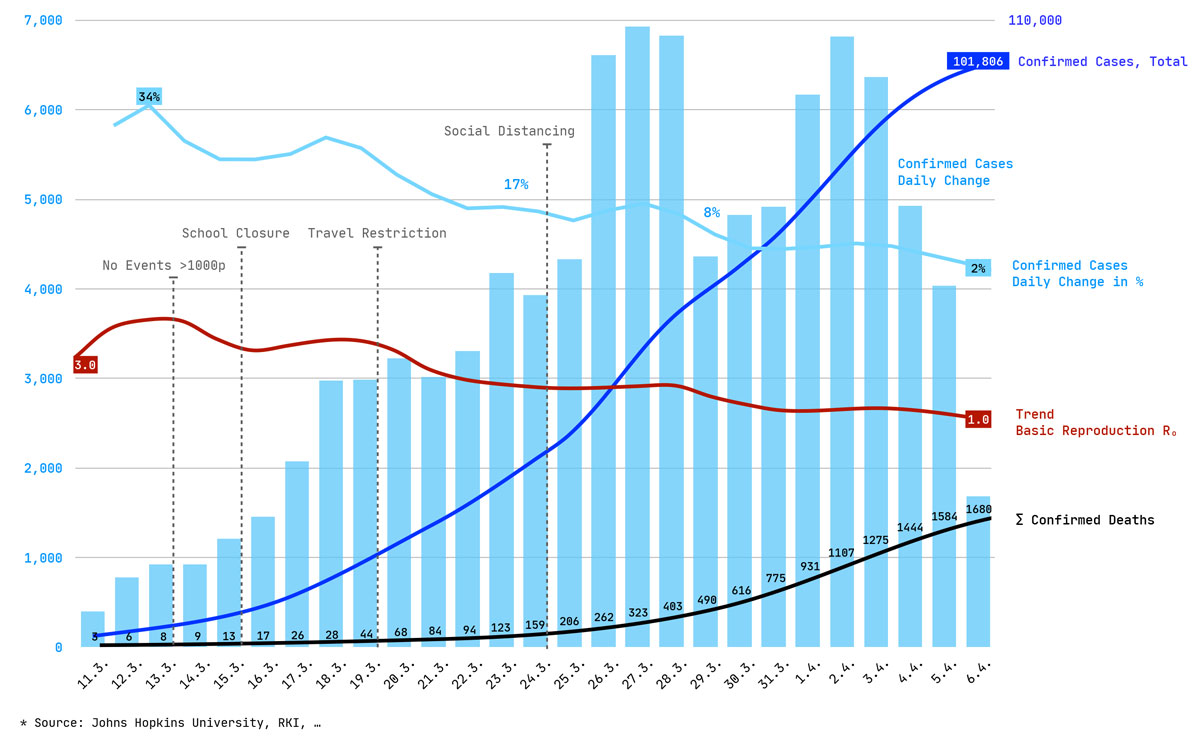
Today’s Covid-19 situation in Germany: new cases (light blue bars), daily change [%] (light blue curve), all cases (dark blue curve), deaths (black), and trend of Basic reproduction number R₀ (reported by RKI)
Sum of confirmed cases (dark blue curve): The development of this amount/number is suitable for showing a country-specific course of the epidemic, but not for international comparisons. The number of cases depends mainly on the number of tests. However, the number does not say anything about the actual amount of infected persons. Its disadvantage is that when the quantity of tests is increased, the curve loses its power as a sample. Another drawback for the statistics: the curve rises and rises, often due to the increase in tests alone, and due to the large total number of cases, the desired flattening can hardly be detected.
Daily change of confirmed cases (light blue bars): A change can be read much more directly from the course of the daily new cases registered. However, the disadvantage built in here is that with the steady increase in the total of registered cases, the absolute numbers of the daily plus are also increasing. Example: If we are in the double digits, the increase of 20 cases from one day to the next sounds small … but it means +50% if there were 40 cases the day before. The jump from 10,000 to 11,000 cases is equivalent to 1,000 new cases, but only a +10% increase. Conclusion: Percentage is the solution.
Daily change of confirmed cases [%], Doubling time (light blue curve): The percentage change in the number of new daily cases most visibly illustrates any trend reversal in the case numbers. Based on the percentage, the doubling time of the virus can be calculated very quickly (see also Fontblog: Ganz einfach die Ausbreitung des Virus ausrechnen). To do this, divide 72 by the percentage of the daily change: 72/Δ%. With the recent 4% (April 5), the current doubling time is 18 days.
Growth rate: Virologists have deduced from experience in China and Italy that the number of reported cases – unchecked – doubles every 3 days. The growth rate is therefore calculated by dividing the number of cases of the current day by the number of cases 3 days before.
Basic reproduction number R₀: The basic reproduction number of an infection can be thought of as the expected number of cases directly generated by one case in a population where all individuals are susceptible to infection. The definition describes the state where no other individuals are infected or immunized (naturally or through vaccination). R₀ is not a biological constant as it is also affected by other factors such as environmental conditions and the behavior of the infected population. Since I have no possibility to calculate R₀, I use the data of the RKI.
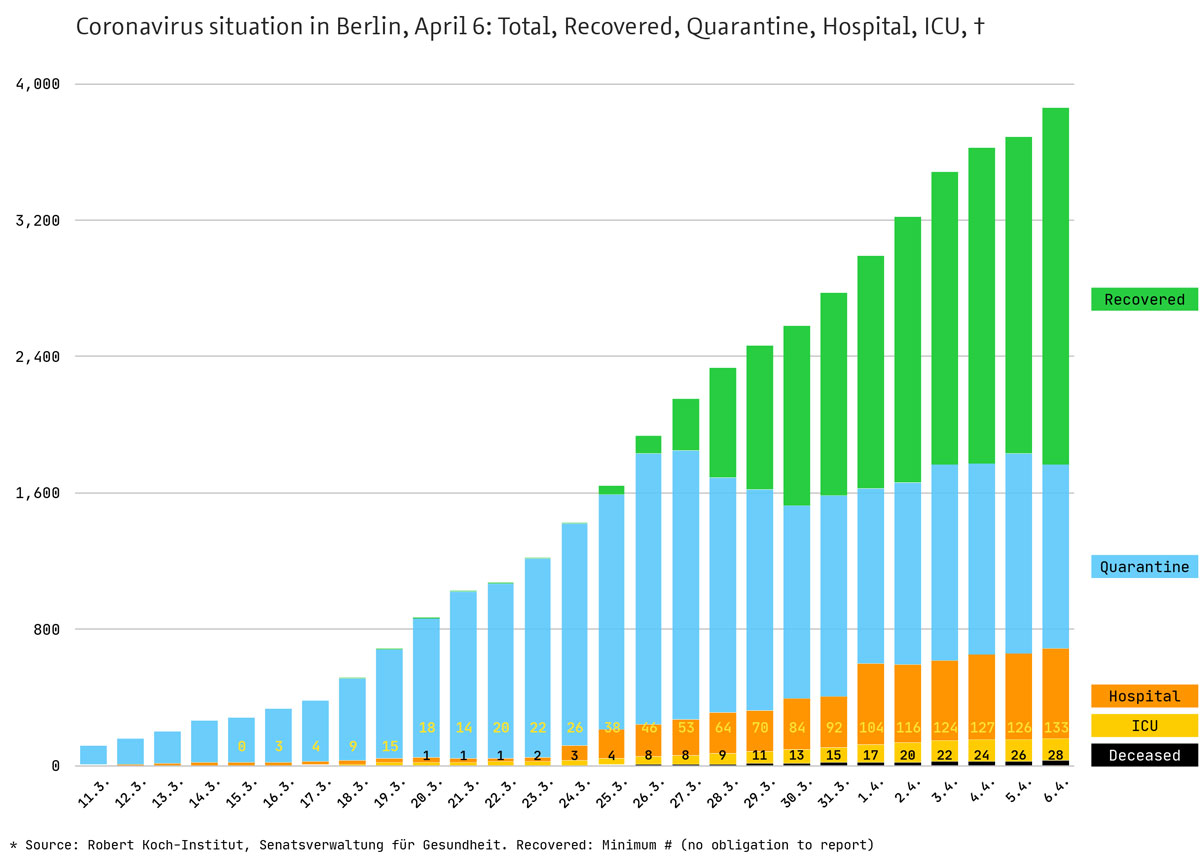
Covid-19 situation in Berlin, April 6: recovered (green), quarantine (blue), hospital (orange), ICU (yellow), deaths (black)
The April 6 table:
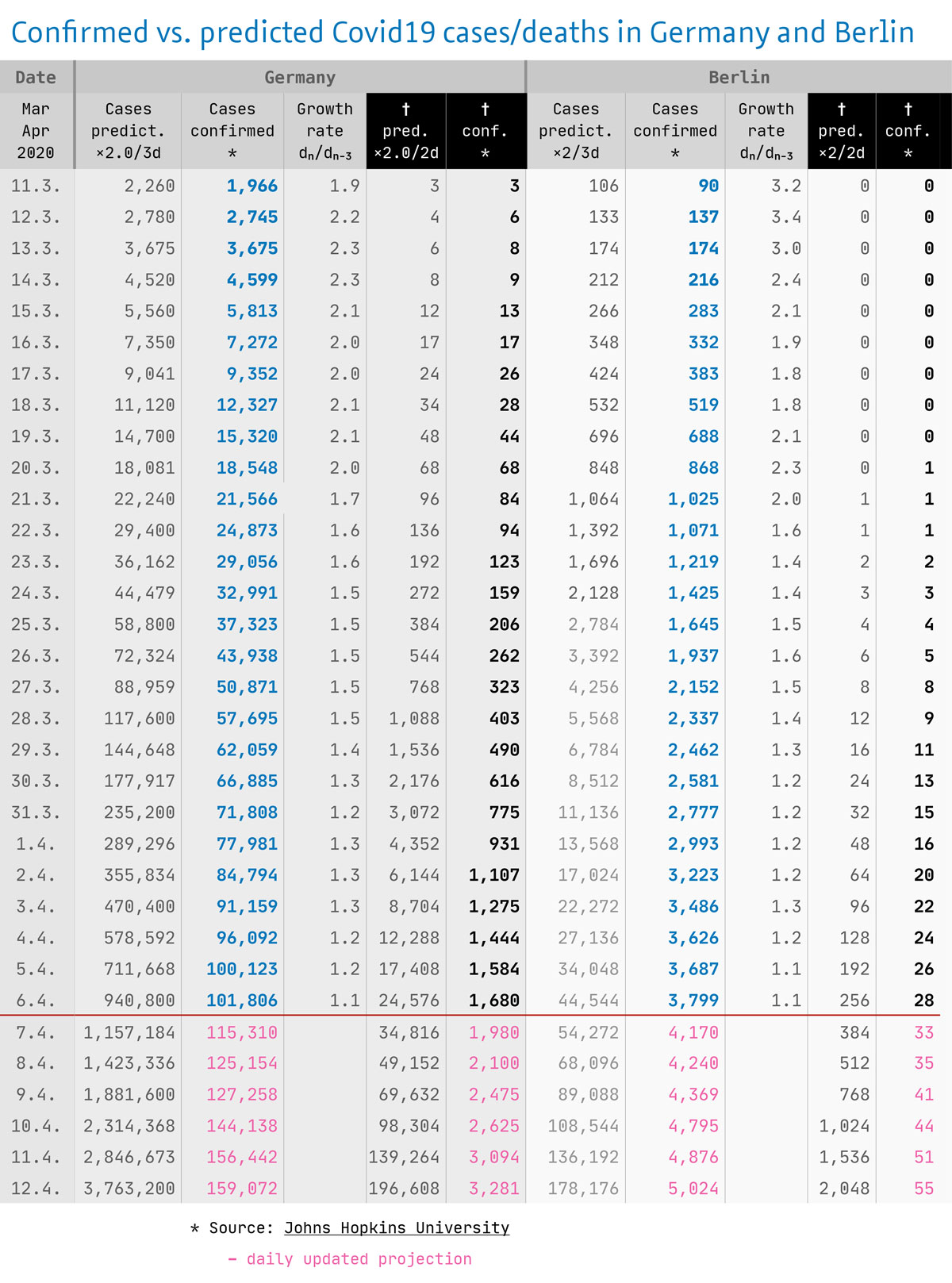
Covid-19 Table Germany and Berlin, April 6
Author’s note: The above values are purely speculative estimations using simple mathematical modelling (based on registered cases/deaths) and are not confirmed by health authorities nor any other national public authority.
Covid-19 Evening Stats, April 05
My main motivation for this personal statistic series was the desire to know and determine the changes in the registered cases and the course of the Covid-19 disease. From the media we learn daily maximum numbers and changes to the previous day. But only when we look at a long-term observation and interpret it correctly can we join in the discussion about the relaxation of political measures.
Since yesterday I have integrated two additional curves into my statistics. One (light blue) shows the course of the percentage changes compared to the previous day, the other one shows the change of the Basic Reproduction Number R₀ (dark red) as reported by the Robert Koch Institute (RKI).
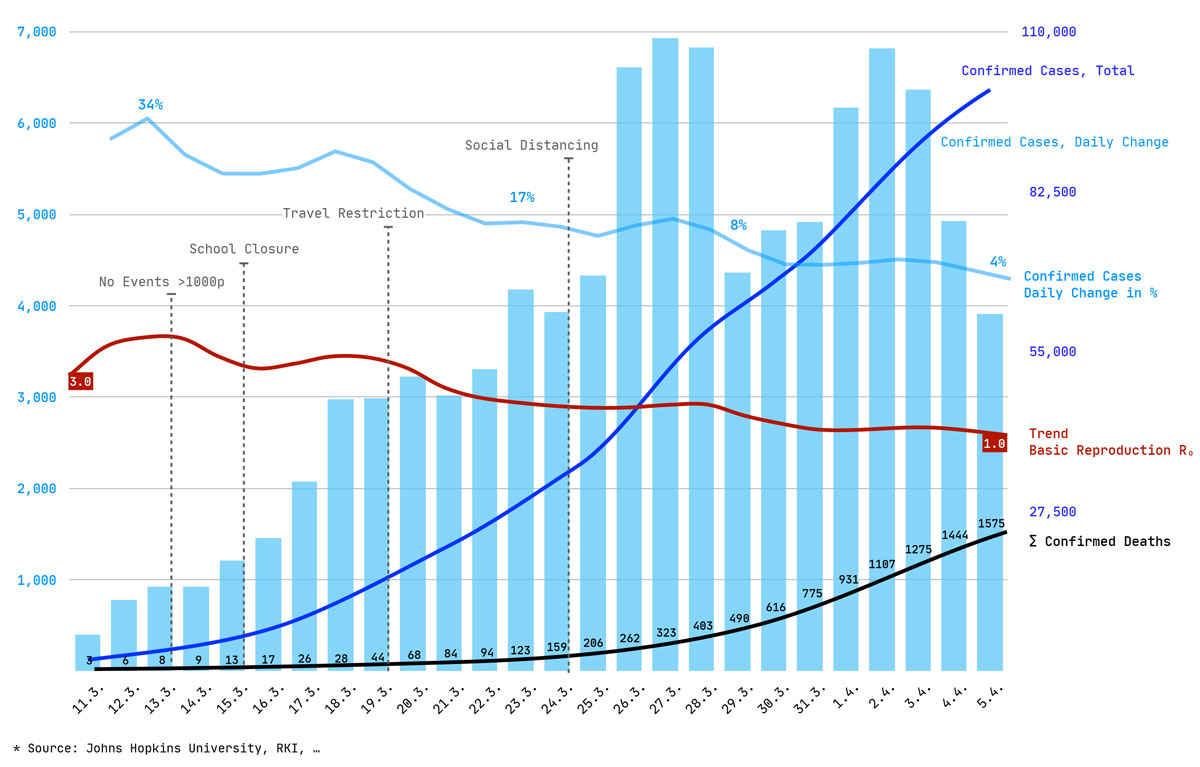
Today’s Covid-19 situation in Germany: new cases (light blue), total cases (dark blue), deaths (black), Basic reproduction number R₀ trend (dark red line), and % new cases (light blue line)
Benefit and weakness of the statistical coronavirus parameters
Sum of confirmed cases (dark blue curve): The development of this amount/number is suitable for showing a country-specific course of the epidemic, but not for international comparisons. The number of cases depends mainly on the number of tests. However, the number does not say anything about the actual amount of infected persons. Its disadvantage is that when the quantity of tests is increased, the curve loses its power as a sample. Another drawback for the statistics: the curve rises and rises, often due to the increase in tests alone, and due to the large total number of cases, the desired flattening can hardly be detected.
Daily change of confirmed cases (light blue bars): A change can be read much more directly from the course of the daily new cases registered. However, the disadvantage built in here is that with the steady increase in the total of registered cases, the absolute numbers of the daily plus are also increasing. Example: If we are in the double digits, the increase of 20 cases from one day to the next sounds small … but it means +50% if there were 40 cases the day before. The jump from 10,000 to 11,000 cases is equivalent to 1,000 new cases, but only a +10% increase. Conclusion: Percentage is the solution.
Daily change of confirmed cases [%], Doubling time (light blue curve): The percentage change in the number of new daily cases most visibly illustrates any trend reversal in the case numbers. Based on the percentage, the doubling time of the virus can be calculated very quickly (see also Fontblog: Ganz einfach die Ausbreitung des Virus ausrechnen). To do this, divide 72 by the percentage of the daily change: 72/Δ%. With the recent 4% (April 5), the current doubling time is 18 days.
Growth rate: Virologists have deduced from experience in China and Italy that the number of reported cases – unchecked – doubles every 3 days. The growth rate is therefore calculated by dividing the number of cases of the current day by the number of cases 3 days before.
Basic reproduction number R₀: The basic reproduction number of an infection can be thought of as the expected number of cases directly generated by one case in a population where all individuals are susceptible to infection. The definition describes the state where no other individuals are infected or immunized (naturally or through vaccination). R₀ is not a biological constant as it is also affected by other factors such as environmental conditions and the behavior of the infected population. Since I have no possibility to calculate R₀, I use the data of the RKI.
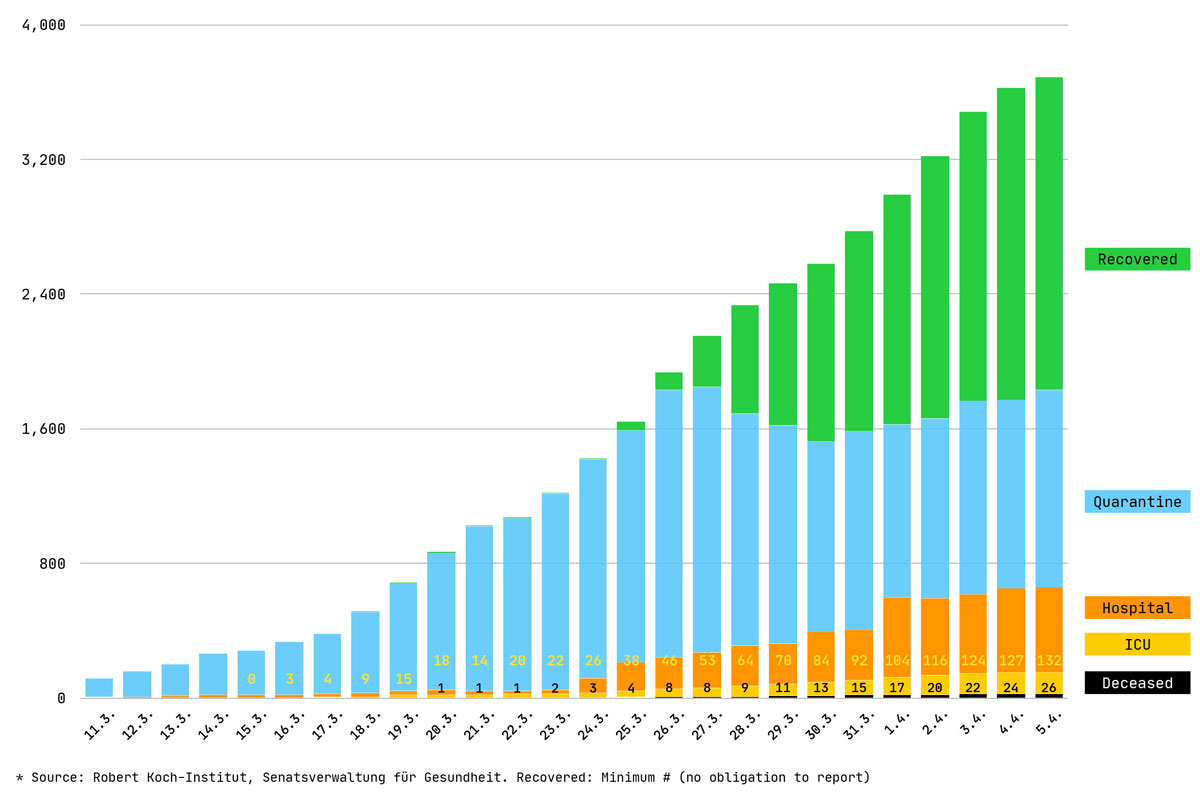
Covid-19 situation in Berlin, April 5: recovered (green), quarantine (blue), hospital (orange), ICU (yellow), deaths (black)
The table:
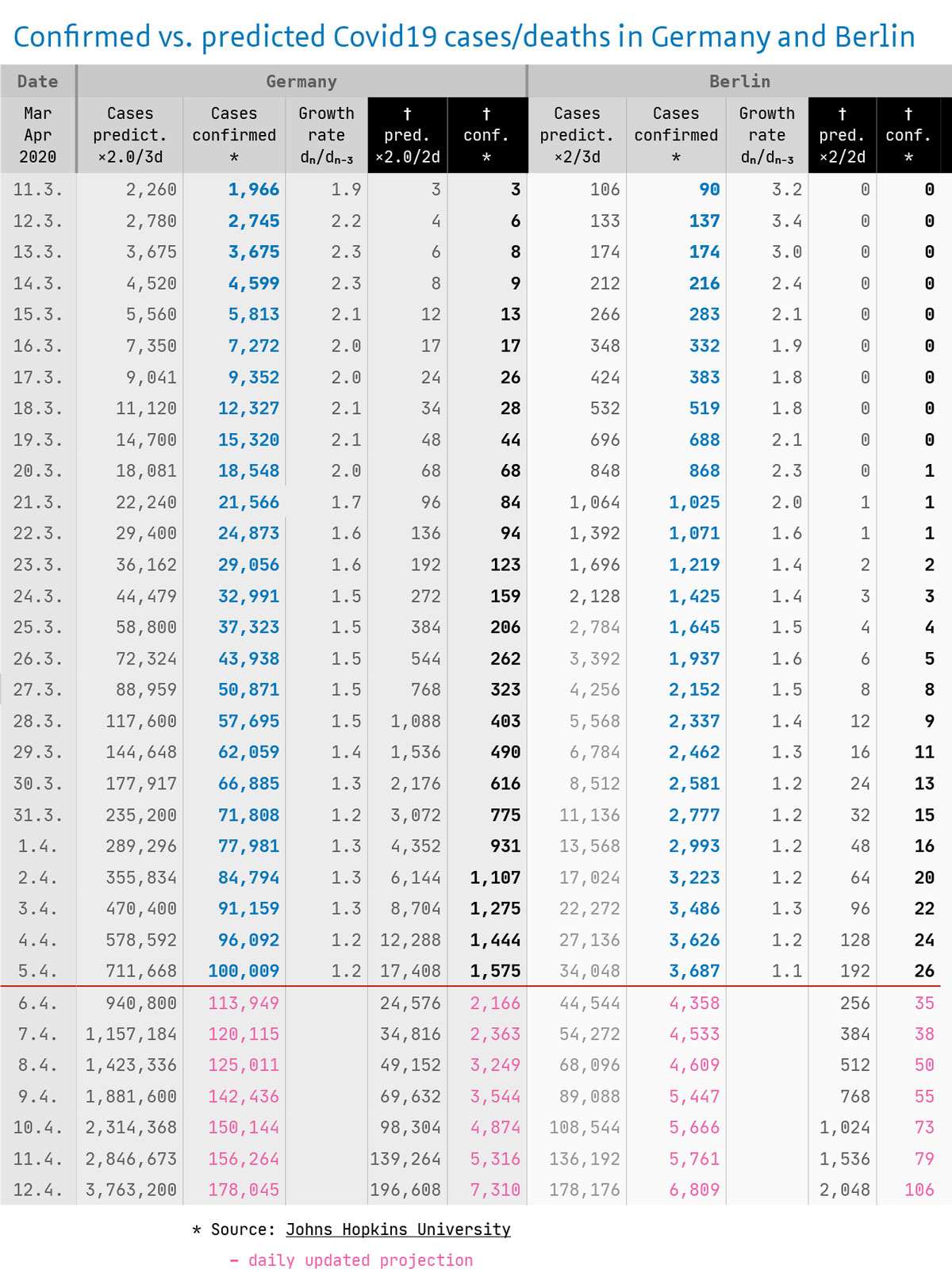
Covid Morning Stats April 04
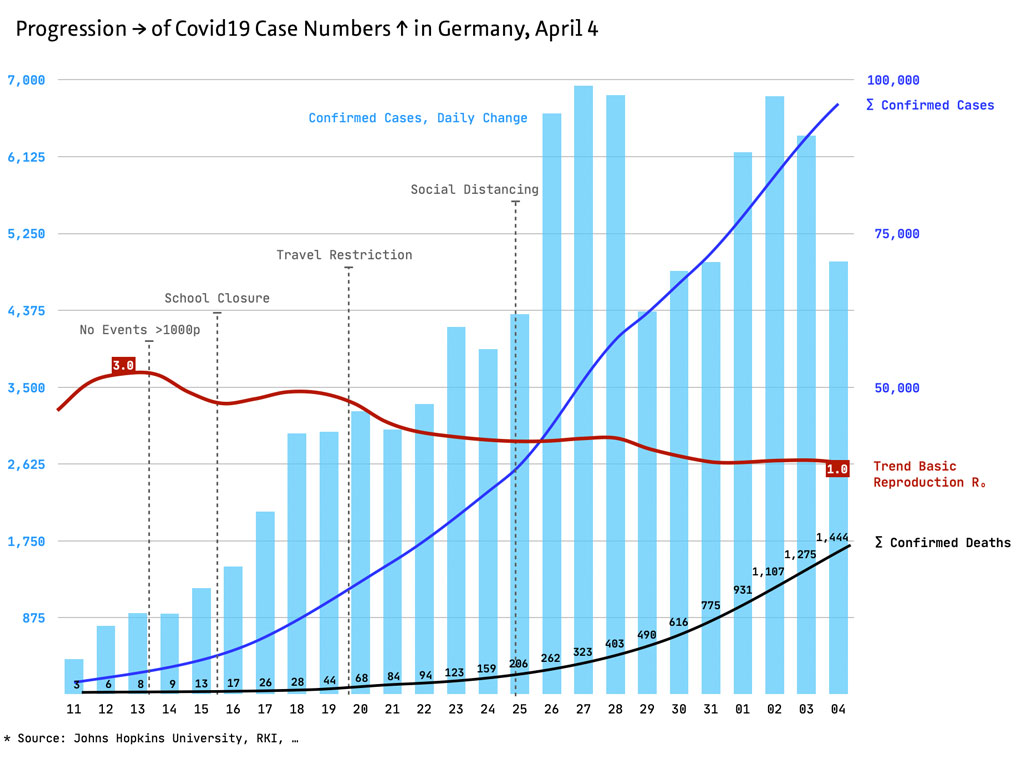
Yesterday’s progression of Covid19 in Germany: new cases (light blue), all cases (dark blue), deaths (black), and [NEW] trend of the Basic reproduction number R₀ (reported by RKI)
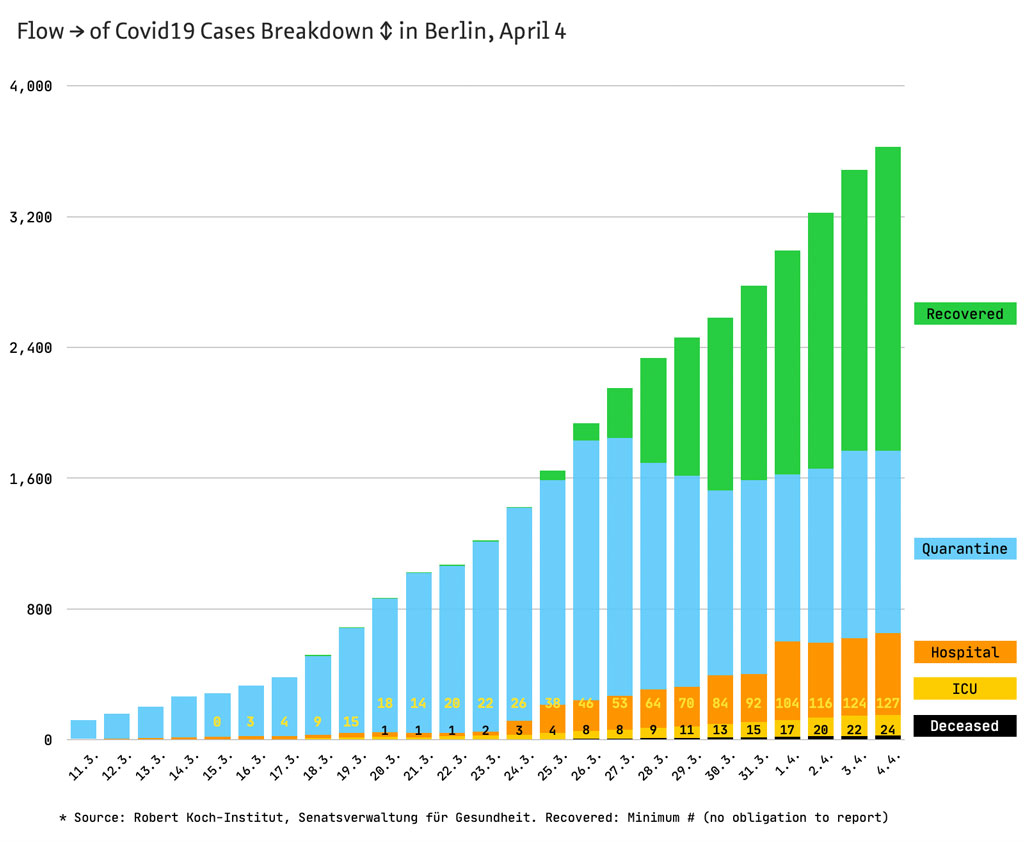
Covid19 situation in Berlin, April 4: recovered (green), quarantine (blue), hospital (orange), ICU (yellow), deaths (black)
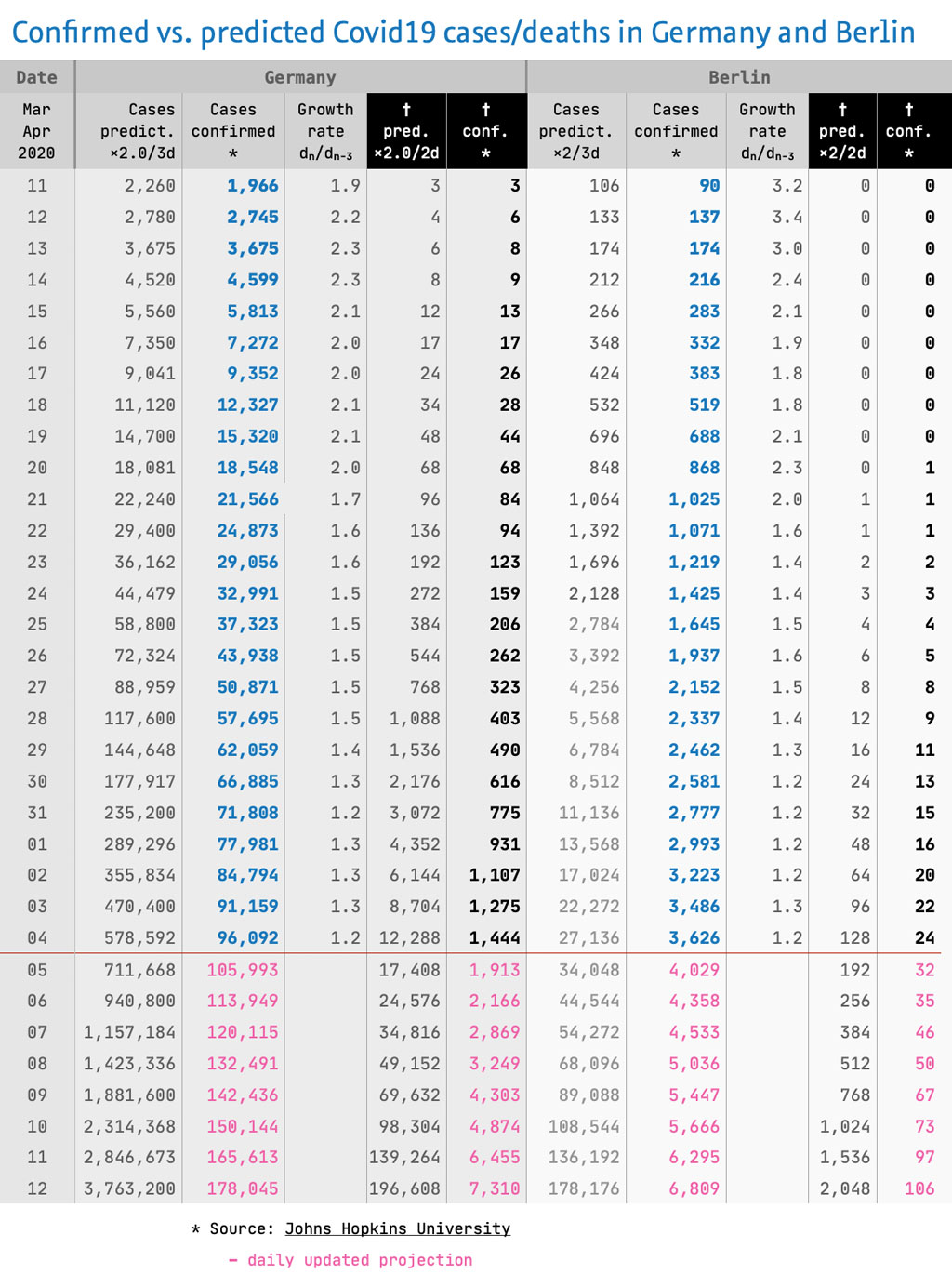
Covid19 Table GER and BER April 4
Covid Morning Stats April 02
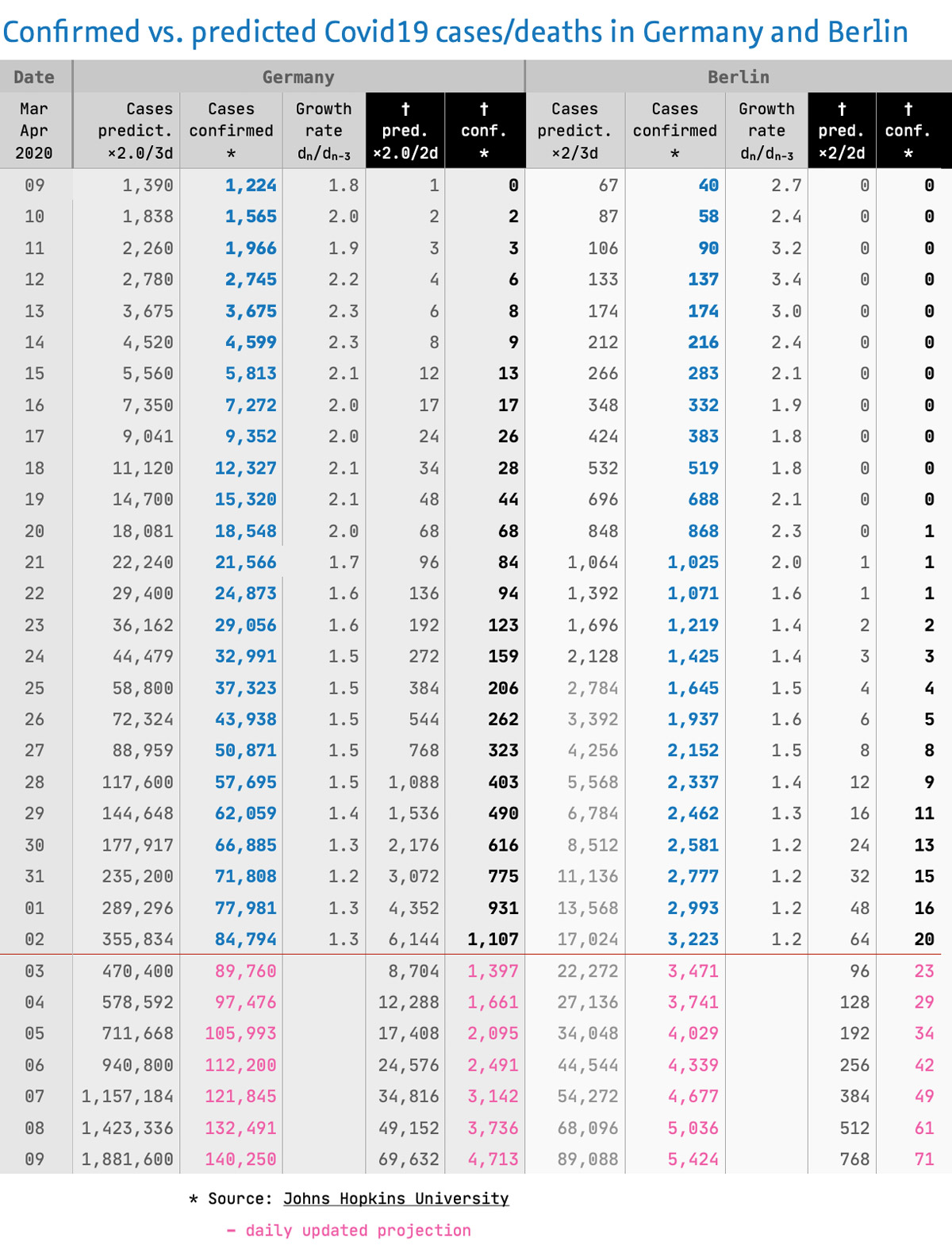
Yesterday’s Covid-19 spreadsheet: registered Cases and Deaths (incl. growth rates) for Germany and Berlin
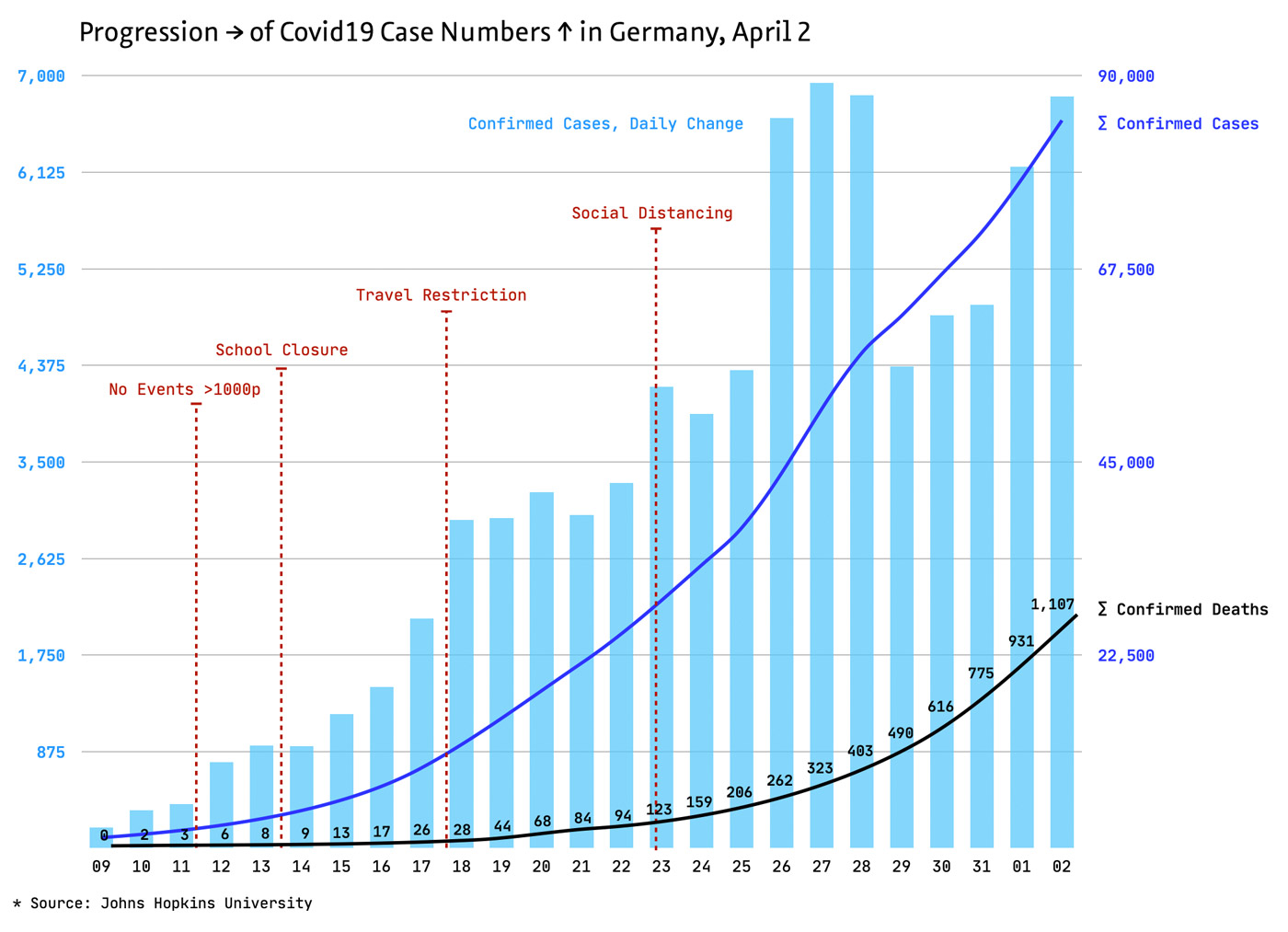
Progression of Covid19 new cases (light blue), all cases (dark blue), and deaths (black) in Germany, April 2
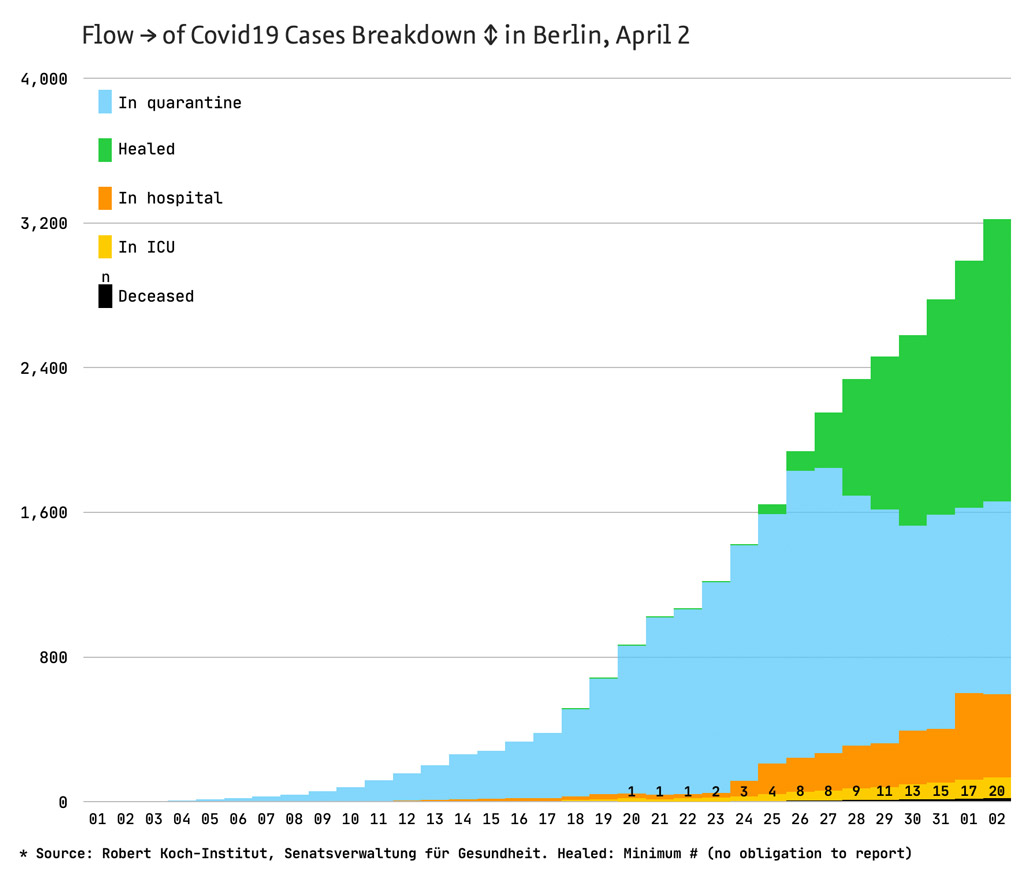
Covid19 situation in Berlin, April 2: recovered (green), quarantine (blue), hospital (orange), ICU (yellow), deaths (black)
Daily Covid19 Stats Nº 22
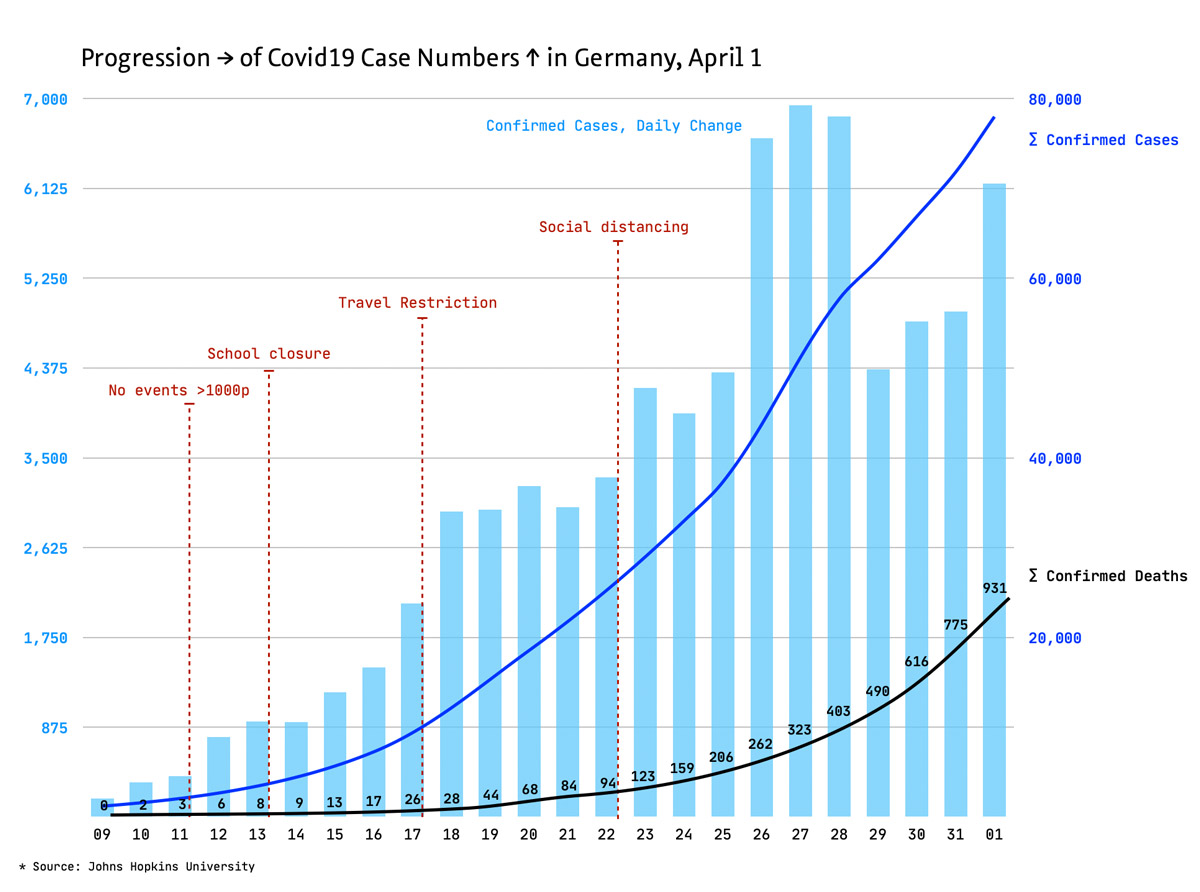
Progression of Covid19 new cases, all cases, and deaths in Germany, April 1
End of Day Summary (22). Yesterday night I decided to set the publication date of my charts (Twitter & blog) from evening to morning because the figure sources are too much in motion at the end of the day.
The picture above shows the increase of the registered Covid19 cases in Germany, from March 9–April 1. The focus is on the daily new cases (light blue bars), where the flattening of the infections is more apparent than in the dark blue curve with the summed cases. The deaths are now visualised with a black, scaled line in order to better recognise the growth; on the line you see the cumulated case numbers.
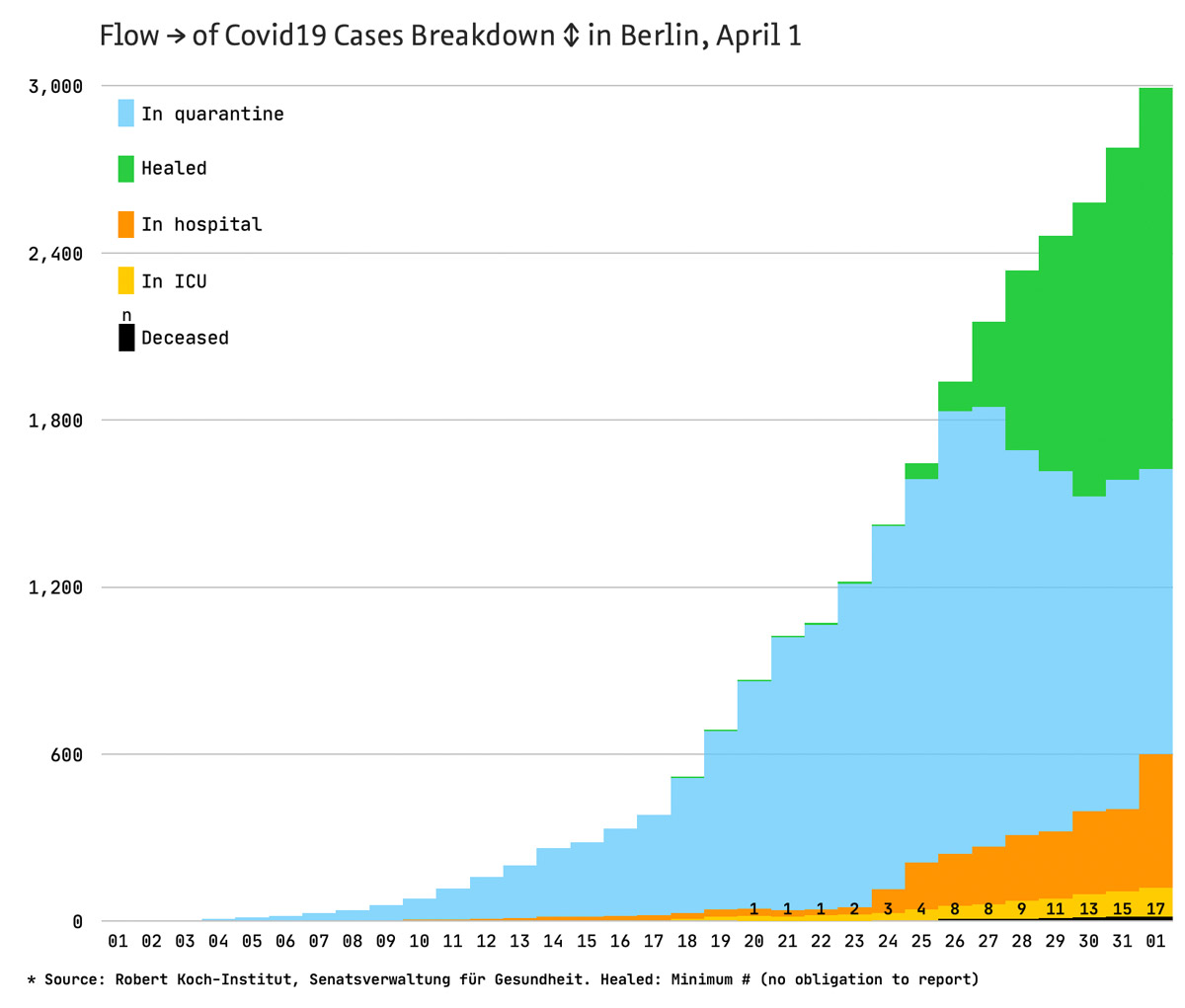
Covid19 situation Berlin, April 1: healed (green), in quarantine (blue), in hospital (orange), in ICU (yello), deaths
The second picture (above) is dedicated to the coronavirus conditions in my hometown Berlin. At the suggestion of some Twitter followers, I have now added up the total number of registered cases against 5 subgroups: the cured (green), the people in domestic quarantine (blue), the Covid19 patients (orange), the severe ICU cases (yellow) and the deaths (black with figures).
You can hardly see it in this presentation, but in the table below: The growth rate in Berlin has now been constant for three days at 1.2 (corresponds to a doubling in about 10 days). Surprisingly, deaths in the city are not growing exponentially but linearly in the last 4 days.
The complete Picture (table):
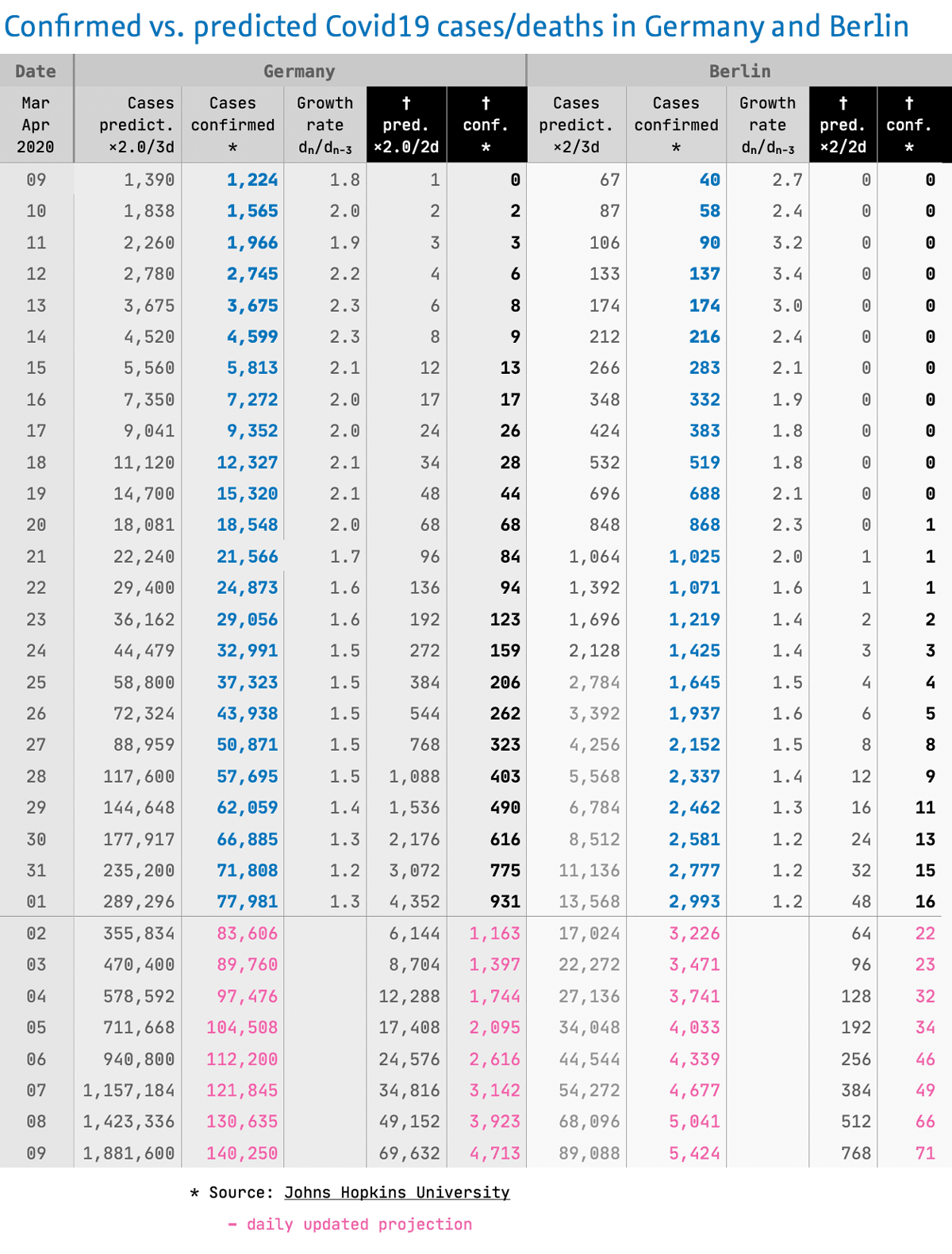
Today, the number of registered cases in Germany has risen by 6,173, and thus the development ha2 increased to a higher growth rate of ×1.3. Let us hope that this can be explained by the large increase in tests. We have to consider: If the number of tests increases dramatically, it naturally distorts the course of our sample.
The increase in the number of deaths has also slowed today, to ×1.5 (from ×1.6 yesterday), which means a doubling in 5 days.
Author’s note: The above values are purely speculative estimations using simple mathematical modelling (based on registered cases/deaths) and are not confirmed by health authorities nor any other national public authority.
Daily Covid-19 Stats Nº 21
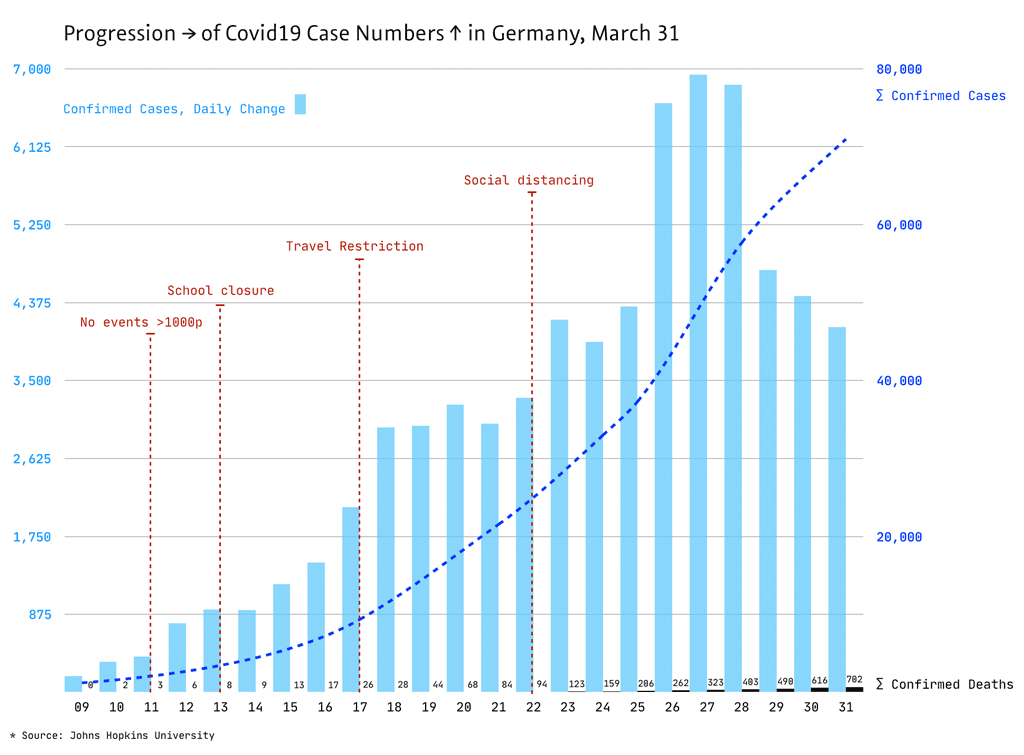
New visualisation of the corona spread in Germany: the daily new cases (bars), sum of the registered cases (dotted line), sum of the dead (black) … in between the political measures to curb the spread
End of Day Summary (21). Apart from my scientific streak, it’s mainly my interest in design that has led me to build my daily coronavirus statistics. That’s why I have rethought and reorganized my style of visualization today. After more than three weeks with steeply rising exponential curves the daily deviations in the lower part of the coordinate systems are hardly noticeable. My focus are now the daily changes, not the forecasts, which can still be seen in the table, as well as the growth rates. The table is now at the end of the article.
The first figure (above) shows the increase of the registered Covid19 cases in Germany, from March 9–31. The focus is now on the daily new cases (bars), where the flattening of the infections is more apparent than in the dotted curve with the summed cases. The deaths (black bars) at the bottom of the chart seem a bit lost … I would like to change that in a revision soon. Particularly when looking back over an entire month, it is helpful to fade in the political measures, some of which at the end of the month seem much further away than they really are.
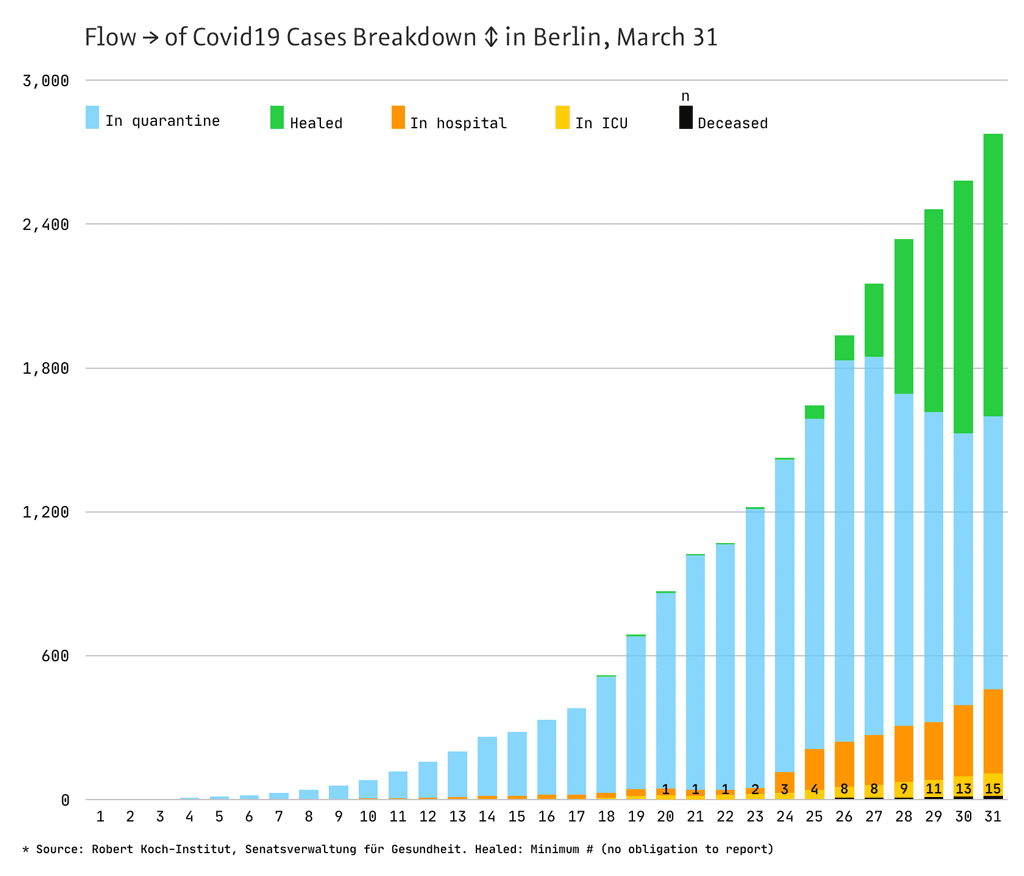
The second picture (above) is dedicated to the coronavirus conditions in my hometown Berlin. At the suggestion of some Twitter followers, I have now added up the total number of registered cases against 5 subgroups: the cured (green), the people in domestic quarantine (blue), the Covid19 patients (orange), the severe ICU cases (yellow) and the deaths (black with figures).
You can hardly see it in this presentation, but in the table below: The growth rate in Berlin today decreased from ×1.4 to ×1.2 (related to 3 days), which corresponds to a doubling of registered cases in 9.5 days. On Saturday, Angela Merkel set the goal “doubling in 10 days” … behold: We are slowly approaching this threshold.
Today’s Table – the complete picture:
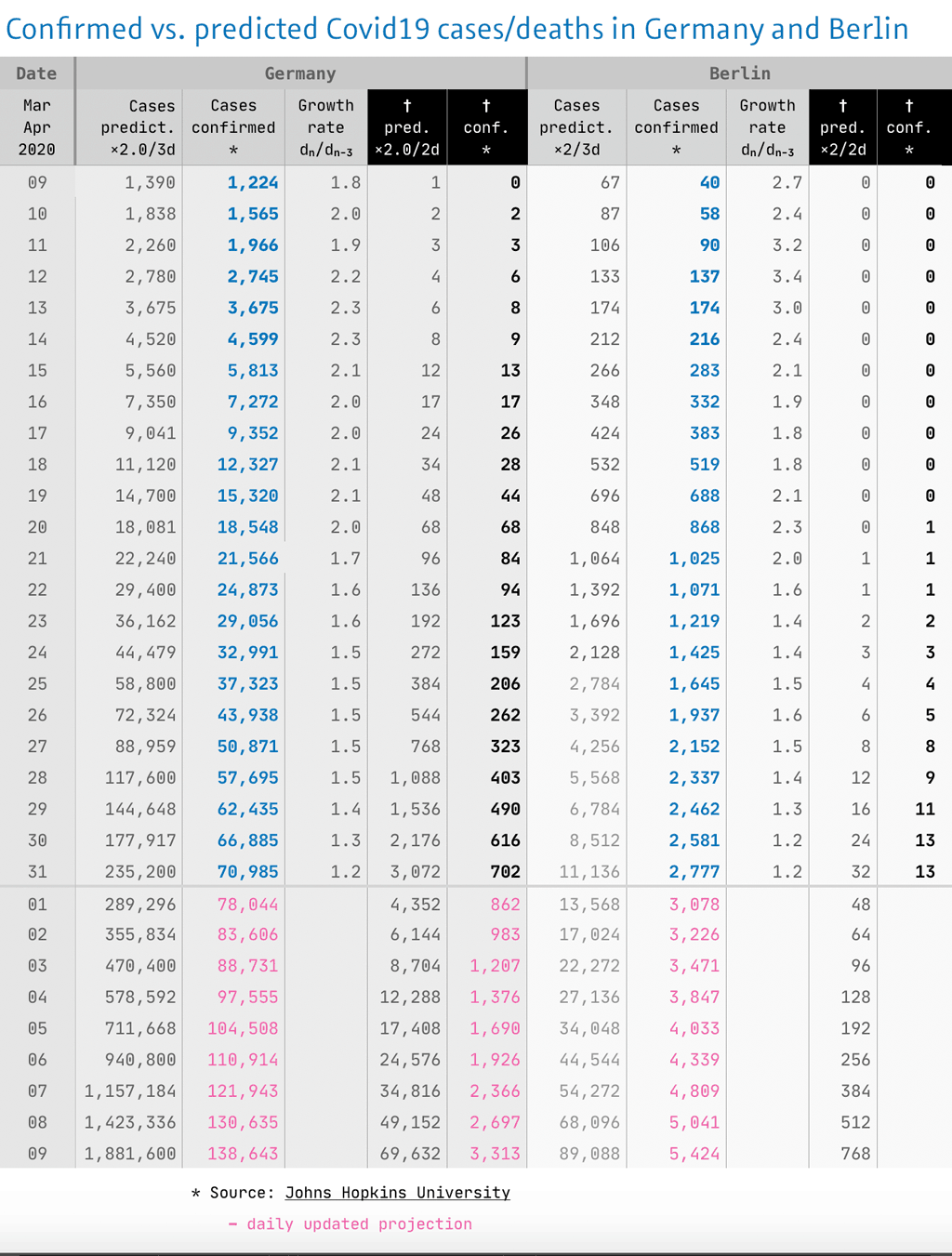
Today, the number of registered cases in Germany has risen by 4100, and thus the development has slowed down again, what is also reflected in the growth rate, which falls by 0.1 for the fourth time: from ×1.5 (Sat), to ×1.4 (Sun), to ×1.3 (yesterday) to ×1.2; this corresponds to a doubling in 9.5 days, which can today really be considered a success of the distancing measures.
The increase in the number of deaths has also slowed today, to ×1.4 (from ×1.5 yesterday, this value had changed overnight), which means a doubling in 5 days and is still unfortunately high. But all virologists confirm that the number of deaths will lag behind the number of cases by at least a week.
Daily Covid-19 Stats Nº 20
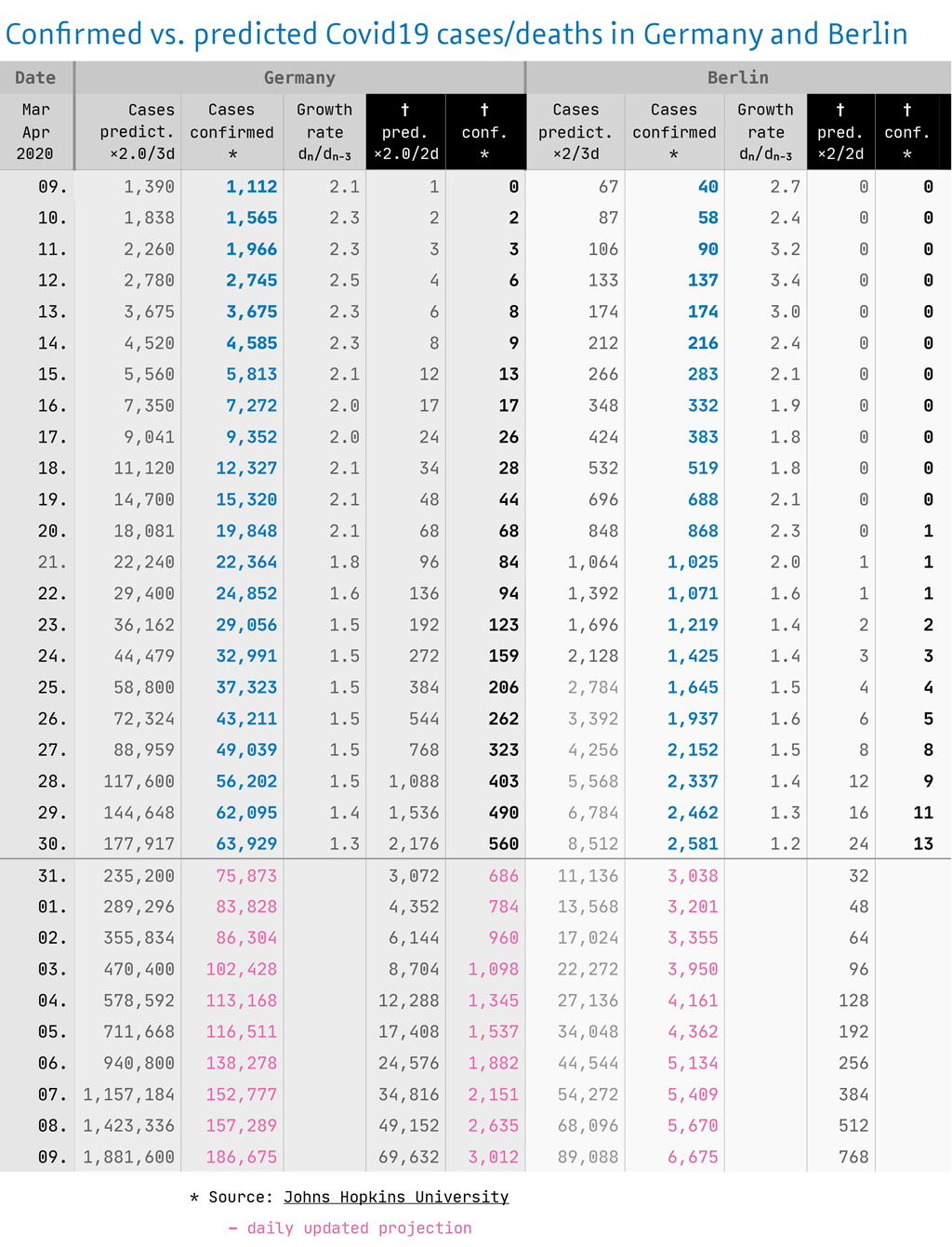
Today’s coronavirus spreadsheet: registered Cases and Deaths in Germany and Berlin today
End of Day Summary (20). Today, the number of registered cases in Germany has risen by 1,834, and thus the development has slowed down considerably, which is also reflected in the lower growth rate: after 6 days with ×1.5 and yesterday with ×1.4 we are down to ×1.3 – the lowest growth rate in over 4 weeks. In view of the fact that the amount of testing has increased significantly in recent days, this could perhaps already be seen as a clear reaction to the social distancing measures.
The increase in the number of deaths has also slowed today, to ×1.4, after having been ×1.5 in each of the last two days, due to the dramatic deaths in 2 nursing homes in northern Germany. The Berlin figures follow the national trend, even a tenth more encouraging: ×1.2 (registered cases) and ×1.4 (registered deaths).

Today’s coronavirus curves for Germany, predicted cases vs. confirmed cases, March 30, 2020
The curve of confirmed cases (blue) is by far flatter than the statistical prediction (gray), with a growth rate of ×1.3.
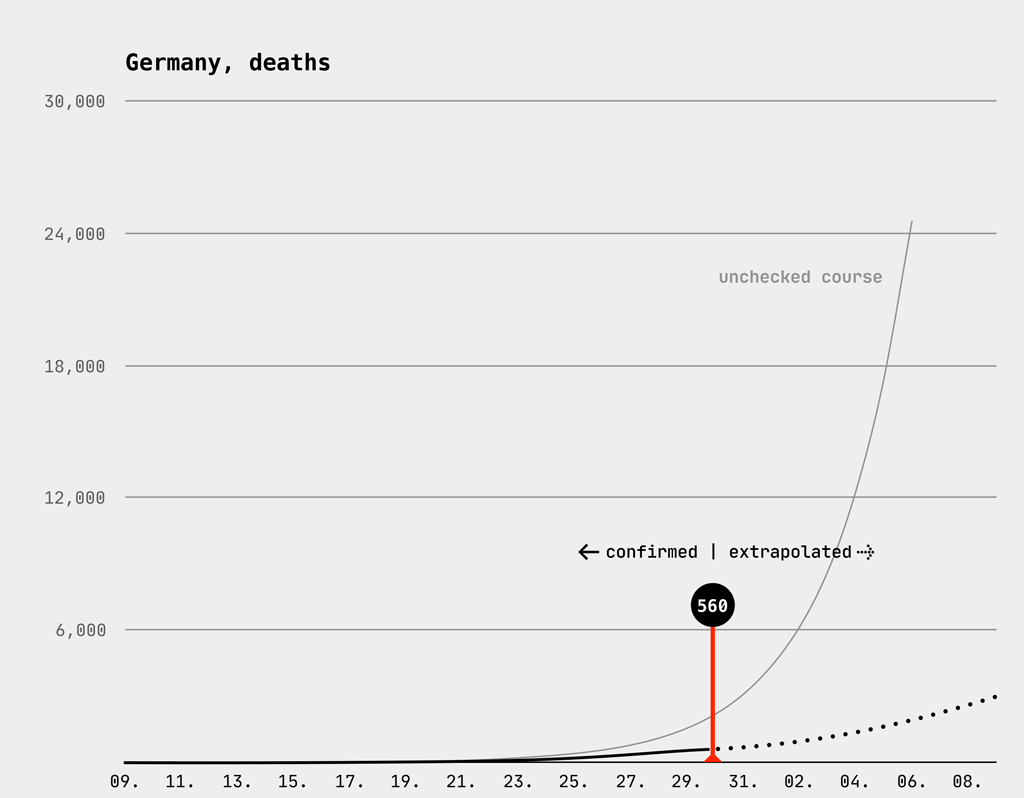
Today’s coronavirus curves for Germany, predicted deaths vs. confirmed deaths, March 30, 2020
The number of deaths is still rising dynamically, bur the growth lowered a bit, from ×1.5 to ×1.4
Author’s note: The above values are purely speculative estimations using simple mathematical modelling (based on registered cases/deaths) and are not confirmed by health authorities nor any other national public authority.